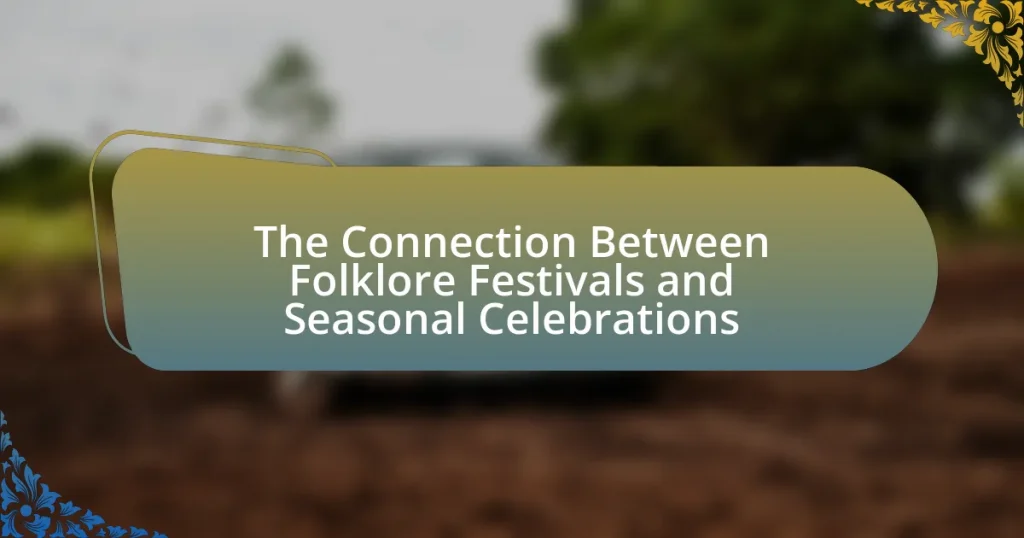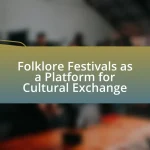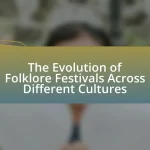Folklore festivals are cultural events that celebrate traditional practices, stories, and customs linked to specific seasons, often featuring music, dance, food, and rituals that reflect community heritage. These festivals are closely tied to seasonal celebrations, commemorating agricultural cycles and reinforcing cultural identity. They hold significant cultural importance by preserving traditions and fostering community bonds, while also providing economic benefits through tourism and local business support. The article explores the relationship between folklore festivals and seasonal celebrations, highlighting their themes, cultural significance, and the challenges they face in modern society.
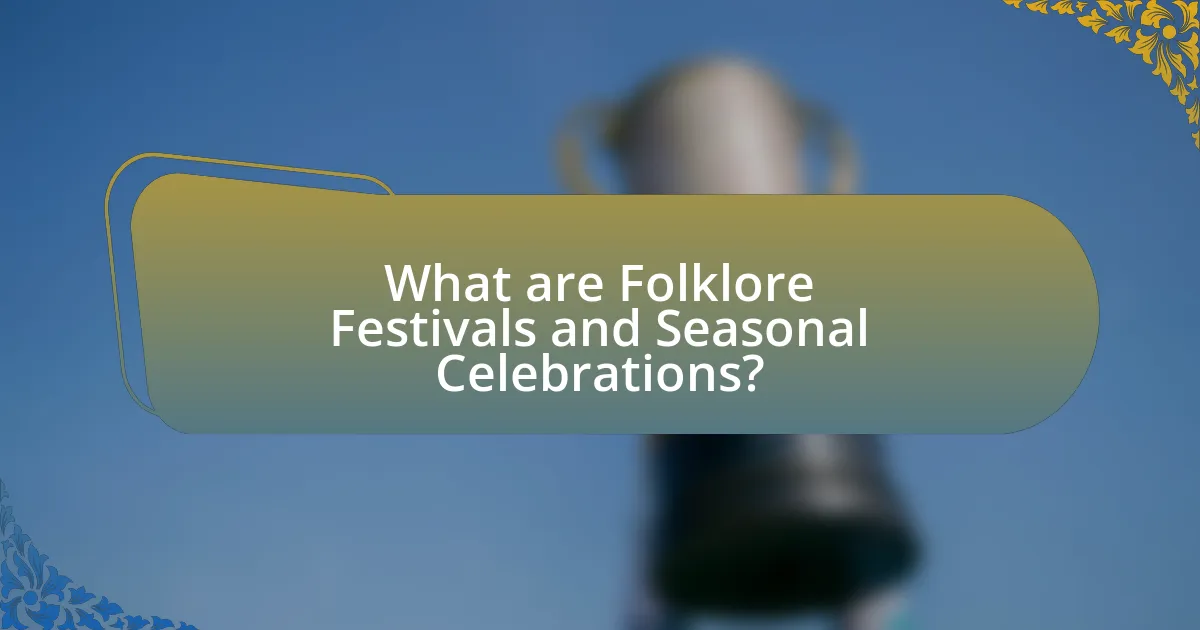
What are Folklore Festivals and Seasonal Celebrations?
Folklore festivals and seasonal celebrations are cultural events that showcase traditional practices, stories, and customs associated with specific times of the year. These festivals often include music, dance, food, and rituals that reflect the heritage and identity of a community. For example, harvest festivals celebrate the gathering of crops and often involve communal feasting and gratitude rituals, while winter solstice celebrations may include storytelling and symbolic activities to mark the return of longer days. Such events serve to strengthen community bonds and preserve cultural narratives, as evidenced by the widespread observance of events like Diwali in India and Midsummer in Scandinavian countries, which highlight the importance of seasonal cycles in folklore.
How do folklore festivals relate to seasonal celebrations?
Folklore festivals are closely tied to seasonal celebrations as they often commemorate agricultural cycles, seasonal changes, and cultural traditions associated with specific times of the year. For instance, many folklore festivals celebrate harvests, such as the Harvest Festival, which marks the end of the growing season and gives thanks for the crops. These festivals typically include traditional music, dance, and storytelling that reflect the community’s cultural heritage and seasonal themes. Historical evidence shows that societies have long used these festivals to reinforce social bonds and cultural identity, with many customs rooted in ancient practices related to the solstices and equinoxes.
What cultural significance do these festivals hold?
Folklore festivals hold significant cultural importance as they serve to preserve and promote traditional customs, stories, and practices within a community. These festivals often reflect the historical and social identity of a culture, allowing participants to connect with their heritage and foster a sense of belonging. For instance, many folklore festivals coincide with seasonal celebrations, marking agricultural cycles or seasonal changes, which reinforces community bonds and shared values. The celebration of these festivals can be traced back to ancient rituals, demonstrating their role in maintaining cultural continuity and educating younger generations about their ancestry.
How do they reflect the changing seasons?
Folklore festivals reflect the changing seasons by celebrating agricultural cycles, natural phenomena, and cultural traditions associated with each time of year. For example, spring festivals often involve themes of renewal and fertility, such as the celebration of planting and blooming flowers, while autumn festivals focus on harvest and gratitude for the bounty of crops. These seasonal celebrations are rooted in historical practices, such as the ancient harvest festivals that marked the end of the growing season, demonstrating a direct connection between folklore and the rhythms of nature.
What are the common themes in folklore festivals?
Common themes in folklore festivals include community bonding, cultural heritage, and seasonal transitions. These festivals often serve as a platform for communities to come together, reinforcing social ties and shared identities. Cultural heritage is celebrated through traditional music, dance, crafts, and storytelling, which preserve and transmit local customs and values. Additionally, many folklore festivals are aligned with seasonal changes, marking agricultural cycles, harvests, or solstices, thus connecting participants to nature and the rhythms of life. For example, harvest festivals often feature rituals and activities that express gratitude for the bounty of the season, highlighting the interdependence between humans and their environment.
How do myths and legends influence festival activities?
Myths and legends significantly influence festival activities by providing thematic narratives that shape the rituals, performances, and customs observed during these events. For instance, many festivals are rooted in ancient stories that celebrate deities, seasonal changes, or historical events, which dictate the activities performed. An example is the Greek festival of Dionysia, where the myth of Dionysus inspired theatrical performances and processions, reflecting the cultural importance of the god of wine and fertility. This connection between mythology and festival activities not only enhances community engagement but also preserves cultural heritage, as seen in various global celebrations like Diwali, which is based on the legend of Rama and Sita, guiding the lighting of lamps and fireworks.
What role do traditional costumes play in these celebrations?
Traditional costumes serve as a vital expression of cultural identity during celebrations. They embody the history, values, and traditions of a community, reinforcing social bonds among participants. For instance, in many folklore festivals, specific garments are worn to represent regional heritage, showcasing unique patterns and colors that reflect local customs. This practice not only honors ancestral legacies but also educates younger generations about their cultural roots, fostering a sense of belonging. Additionally, traditional costumes often enhance the visual spectacle of these events, attracting visitors and promoting cultural tourism, which can be economically beneficial for the community.
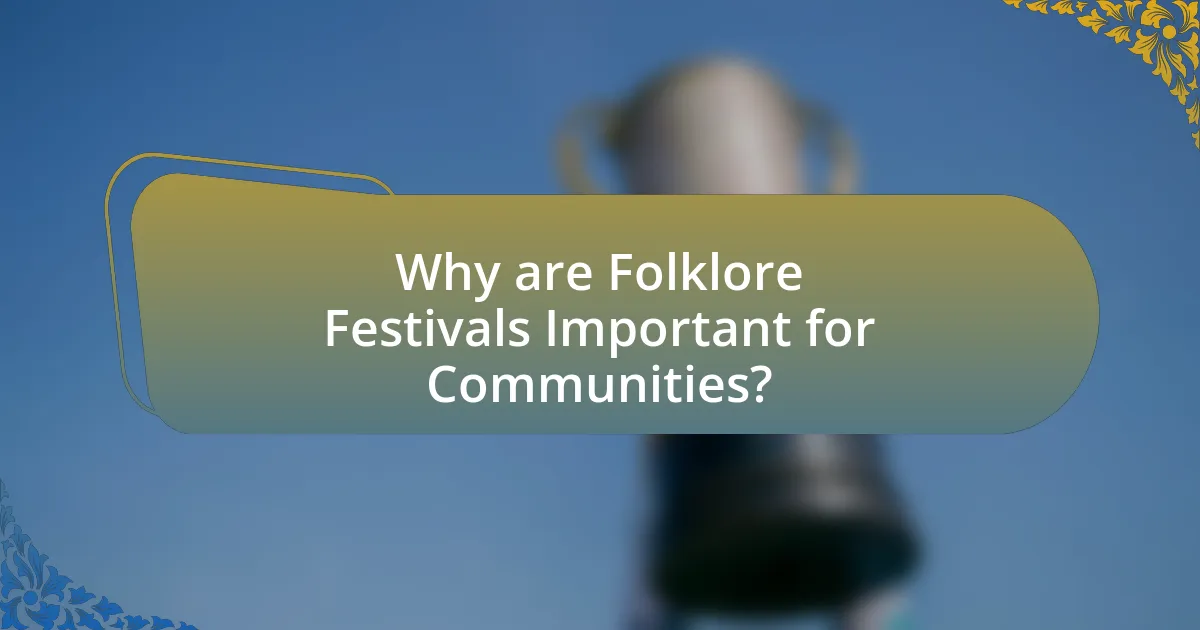
Why are Folklore Festivals Important for Communities?
Folklore festivals are important for communities because they preserve cultural heritage and foster social cohesion. These events provide a platform for sharing traditional stories, music, and dance, which strengthens community identity and continuity. For instance, studies show that participation in folklore festivals can enhance community bonds and promote intergenerational connections, as families and individuals come together to celebrate shared traditions. Additionally, folklore festivals often stimulate local economies by attracting tourism, which can lead to increased revenue for local businesses. This economic impact further reinforces the community’s commitment to maintaining its cultural practices.
How do these festivals promote cultural heritage?
Festivals promote cultural heritage by serving as platforms for the expression and preservation of traditional practices, customs, and narratives. These events often feature performances, crafts, and rituals that reflect the historical and social contexts of a community, thereby reinforcing collective identity. For instance, the annual Oktoberfest in Germany showcases traditional Bavarian music, food, and attire, which helps maintain and celebrate regional customs. Additionally, research indicates that participation in cultural festivals can enhance community cohesion and pride, as evidenced by a study published in the Journal of Cultural Heritage Management and Sustainable Development, which found that such events foster intergenerational knowledge transfer and cultural continuity.
What impact do they have on local identity?
Folklore festivals and seasonal celebrations significantly enhance local identity by fostering community cohesion and cultural pride. These events serve as platforms for the expression of unique traditions, stories, and practices that define a community’s heritage. For instance, festivals often feature local music, dance, and cuisine, which not only celebrate but also preserve cultural narratives. Research indicates that participation in such events strengthens social bonds among residents, as seen in studies like “The Role of Festivals in Community Development” by Smith and Jones, published in the Journal of Cultural Geography, which highlights how local festivals contribute to a shared sense of belonging and identity.
How do they foster community bonding?
Folklore festivals and seasonal celebrations foster community bonding by bringing people together through shared cultural experiences and traditions. These events create opportunities for social interaction, allowing individuals to connect with one another while participating in activities such as music, dance, and storytelling that reflect their collective heritage. Research indicates that communal participation in such festivals enhances social cohesion and strengthens community identity, as evidenced by studies showing increased trust and collaboration among participants in local events.
What economic benefits do folklore festivals provide?
Folklore festivals provide significant economic benefits by attracting tourism, generating local revenue, and creating job opportunities. These festivals draw visitors who spend money on accommodations, food, and local crafts, which stimulates the economy of the host community. For instance, a study by the National Endowment for the Arts found that cultural events can increase local business revenues by up to 30% during festival periods. Additionally, folklore festivals often require staffing for event management, security, and vendors, thereby creating temporary and sometimes permanent jobs in the area. This influx of economic activity not only supports local businesses but also enhances community engagement and cultural preservation.
How do they contribute to local tourism?
Folklore festivals and seasonal celebrations significantly contribute to local tourism by attracting visitors who seek cultural experiences. These events often showcase traditional music, dance, crafts, and cuisine, which enhance the appeal of the destination. For instance, a study by the National Endowment for the Arts found that cultural events can increase local tourism revenue by up to 30%, as they encourage both day-trippers and overnight stays. Additionally, folklore festivals often promote local artisans and businesses, further stimulating the economy and creating a vibrant atmosphere that draws tourists.
What opportunities do they create for local businesses?
Folklore festivals and seasonal celebrations create significant opportunities for local businesses by increasing foot traffic and enhancing community engagement. These events attract visitors who spend money on food, crafts, and services, thereby boosting sales for local vendors. For instance, a study by the National Endowment for the Arts found that cultural events can increase local economic activity by up to 20%, as they encourage both residents and tourists to explore local shops and eateries. Additionally, these festivals often provide platforms for local artisans and performers, allowing them to showcase their products and talents, which can lead to increased brand recognition and customer loyalty.
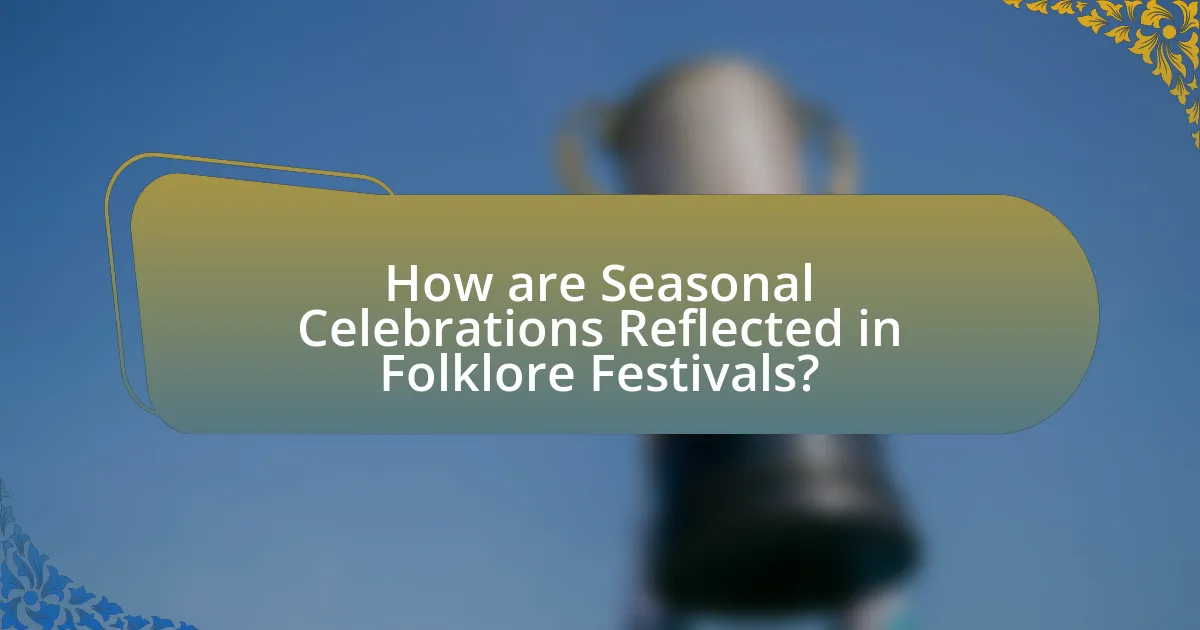
How are Seasonal Celebrations Reflected in Folklore Festivals?
Seasonal celebrations are reflected in folklore festivals through the incorporation of traditional customs, rituals, and narratives that align with specific times of the year. For instance, many folklore festivals celebrate agricultural cycles, such as harvest festivals, which include rituals to honor the earth and ensure bountiful crops. These festivals often feature folk music, dance, and storytelling that convey the cultural significance of the season. Historical examples include the harvest festivals in various cultures, where communities gather to celebrate the end of the growing season, showcasing local produce and traditional dishes, thereby reinforcing communal bonds and cultural identity.
What seasonal elements are commonly celebrated?
Seasonal elements commonly celebrated include the changing of seasons, harvests, solstices, and equinoxes. For instance, spring is often celebrated with festivals that honor renewal and fertility, such as Easter and Holi, which symbolize rebirth and color. Summer celebrations often focus on the abundance of crops, as seen in Midsummer festivals and harvest fairs. Autumn is marked by harvest festivals like Thanksgiving and the celebration of the autumn equinox, which acknowledges the gathering of crops. Winter celebrations, such as Christmas and the Winter Solstice, highlight themes of light and warmth during the coldest months. These celebrations are rooted in agricultural practices and cultural traditions that reflect the natural cycles of the earth.
How do agricultural cycles influence festival timing?
Agricultural cycles significantly influence festival timing by aligning celebrations with key agricultural events such as planting, harvesting, and seasonal changes. For instance, many harvest festivals occur after the completion of the harvest season, celebrating the abundance of crops and giving thanks for the yield. This alignment is evident in festivals like Thanksgiving in the United States, which coincides with the autumn harvest. Additionally, spring festivals often mark the beginning of planting season, as seen in festivals like Holi in India, which celebrates the arrival of spring and the start of agricultural activities. These connections between agricultural cycles and festival timing highlight the cultural importance of agriculture in shaping community celebrations and traditions.
What natural phenomena are honored during these celebrations?
Natural phenomena honored during these celebrations include the changing seasons, harvest cycles, and celestial events. For instance, many folklore festivals celebrate the arrival of spring with rituals that honor rebirth and renewal, such as the Spring Equinox, which marks equal day and night. Additionally, harvest festivals, like Thanksgiving, recognize the bounty of crops and the importance of agriculture, reflecting the relationship between humans and the earth’s cycles. Celestial events, such as solstices, are also celebrated, with the Summer Solstice often associated with the longest day of the year and various cultural rituals that acknowledge the sun’s significance in sustaining life.
How do different cultures celebrate the same season?
Different cultures celebrate the same season through unique festivals and traditions that reflect their historical and social contexts. For example, spring is celebrated with Holi in India, a festival of colors symbolizing the arrival of spring and the victory of good over evil, while in Japan, Hanami involves viewing cherry blossoms, signifying the beauty and transience of life. Both celebrations occur in spring but highlight distinct cultural values and practices. The diversity in these celebrations illustrates how seasonal changes are interpreted through various cultural lenses, reinforcing community bonds and shared heritage.
What are some examples of cross-cultural seasonal festivals?
Examples of cross-cultural seasonal festivals include Diwali, celebrated in India and by Indian communities worldwide, which signifies the victory of light over darkness. Another example is the Lunar New Year, observed in various Asian cultures, including Chinese, Vietnamese, and Korean traditions, marking the beginning of the lunar calendar. Additionally, Harvest Festivals, such as Thanksgiving in the United States and the Mid-Autumn Festival in China, celebrate the bounty of the harvest season across different cultures. These festivals often share themes of gratitude, renewal, and community, reflecting universal human experiences.
How do local customs shape these celebrations?
Local customs significantly shape celebrations by influencing the rituals, symbols, and practices that define these events. For instance, in many cultures, seasonal celebrations incorporate traditional foods, music, and dances that reflect the community’s history and values. Specific customs, such as the use of particular colors or the performance of unique dances, can be traced back to historical events or agricultural practices, thereby reinforcing cultural identity. In regions where harvest festivals are celebrated, local agricultural products often take center stage, showcasing the community’s reliance on and appreciation for the land. This integration of local customs not only enriches the celebration but also fosters a sense of belonging and continuity among participants.
What are the challenges faced by folklore festivals today?
Folklore festivals today face several significant challenges, including declining attendance, funding shortages, and cultural appropriation. Declining attendance is often attributed to changing demographics and interests, with younger generations showing less engagement in traditional practices. Funding shortages arise as many festivals rely on sponsorships and grants, which have become increasingly competitive and limited. Cultural appropriation poses a challenge as festivals strive to maintain authenticity while navigating the complexities of representation and respect for the cultures being showcased. These challenges threaten the sustainability and relevance of folklore festivals in contemporary society.
How is modernization affecting traditional practices?
Modernization is significantly impacting traditional practices by introducing new technologies and cultural influences that often overshadow or alter them. For instance, the rise of digital media has transformed how folklore festivals are celebrated, with many events now incorporating online platforms for promotion and participation, which can dilute the authenticity of traditional practices. Research indicates that as communities adopt modern conveniences, such as fast food and digital entertainment, the attendance and engagement in traditional seasonal celebrations decline, leading to a potential loss of cultural heritage. This shift is evidenced by studies showing that younger generations are increasingly drawn to modern lifestyles, resulting in fewer participants in traditional events, which are essential for preserving cultural identity.
What strategies can be employed to preserve these festivals?
To preserve folklore festivals, communities can implement strategies such as engaging local stakeholders, promoting cultural education, and utilizing digital platforms for outreach. Engaging local stakeholders, including artisans, performers, and community leaders, fosters a sense of ownership and encourages participation, which is crucial for the sustainability of these events. Promoting cultural education through workshops and school programs raises awareness among younger generations about the significance of these festivals, ensuring their relevance and continuity. Additionally, utilizing digital platforms for outreach allows for broader participation and visibility, as seen in the success of virtual festivals during the COVID-19 pandemic, which maintained community engagement despite physical restrictions. These strategies collectively enhance the preservation of folklore festivals by reinforcing community ties and adapting to contemporary challenges.
What are some best practices for organizing folklore festivals?
To effectively organize folklore festivals, it is essential to establish a clear theme that reflects the cultural significance of the folklore being celebrated. This theme guides all aspects of the festival, from programming to marketing. Engaging local communities and stakeholders is crucial, as their involvement ensures authenticity and fosters a sense of ownership. Additionally, securing diverse performers and artisans who specialize in traditional crafts and storytelling enhances the festival’s richness and appeal.
Logistical planning, including venue selection, permits, and safety measures, must be meticulously executed to ensure a smooth experience for attendees. Marketing strategies should leverage social media and local partnerships to reach a broader audience, while also emphasizing the festival’s unique cultural aspects. Finally, gathering feedback from participants post-event can provide valuable insights for future improvements, ensuring the festival evolves and remains relevant to the community it serves.
How can communities effectively engage participants?
Communities can effectively engage participants by creating inclusive and interactive experiences that resonate with cultural traditions. For instance, folklore festivals often incorporate local customs, storytelling, and hands-on activities that invite participation, fostering a sense of belonging and connection among attendees. Research indicates that events that actively involve participants, such as workshops or performances, enhance engagement levels significantly. A study by the National Endowment for the Arts found that participatory arts activities increase community cohesion and individual satisfaction, demonstrating the effectiveness of such engagement strategies.
What role does marketing play in the success of these festivals?
Marketing plays a crucial role in the success of folklore festivals by driving attendance, enhancing visibility, and fostering community engagement. Effective marketing strategies, such as targeted advertising and social media campaigns, attract diverse audiences, which is essential for the financial viability of these events. For instance, a study by the National Endowment for the Arts found that festivals with robust marketing efforts saw attendance increases of up to 30%, demonstrating the direct correlation between marketing initiatives and festival success. Additionally, marketing helps to create a unique brand identity for each festival, allowing them to stand out in a competitive landscape and build a loyal following over time.










